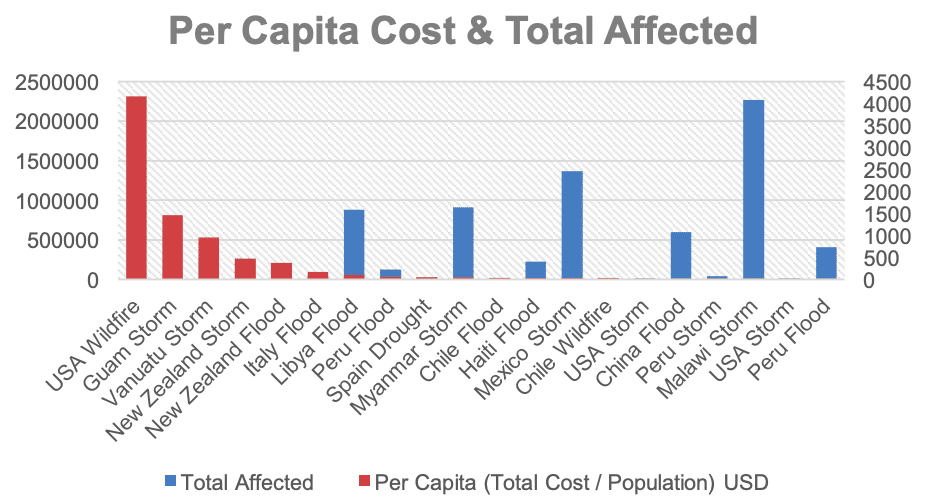The 20 costliest climate disasters of 2023 disproportionately affected developing countries that have less economic resources and lack adequate infrastructure to withstand natural calamities.
—
Low-income, small countries are more prone to experience economically costly disasters, a new analysis of the costliest climate disasters of 2023 has found.
The study, carried out by Christian Aid and published Wednesday, looked at the top 20 costliest climate disasters of 2023 across 14 countries, including floods, storms, droughts, and wildfires, and found that the relative economic impact of these disasters is “highly unequal.”
| Rank | Country | Event type | Cost per person (US$) |
| 1 | Hawaii – USA | Wildfire | 4,161 |
| 2 | Guam | Storm | 1,455 |
| 3 | Vanuatu | Storm | 947 |
| 4 | New Zealand | Storm | 468 |
| 5 | New Zealand | Flood | 371 |
| 6 | Italy | Flood | 164 |
| 7 | Libya | Flood | 105 |
| 8 | Peru | Flood | 66 |
| 9 | Spain | Drought | 50 |
| 10 | Myanmar | Storm | 41 |
| 11 | Chile | Flood | 39 |
| 12 | Haiti | Flood | 36 |
| 13 | Mexico | Storm | 35 |
| 14 | Chile | Wildfire | 30 |
| 15 | USA | Storm | 25 |
| 16 | China | Flood | 23 |
| 17 | Peru | Storm | 20 |
| 18 | Malawi | Storm | 17 |
| 19 | USA | Storm | 16 |
| 20 | Peru | Flood | 9 |
Indeed, wealthier countries that have enough resources to prepare and adapt for potential future extreme weather events are better off than poorer countries, which often lack adequate infrastructure to withstand and financial resources to bounce back after a disaster. In the latter, not only is the death toll generally higher but recovery is also much slower. What’s more, we are witnessing a “double injustice” – as the study puts it – since the countries most prone to extreme weather events are those who contribute the least to global warming in the first place.
The per capita cost of this year’s disasters ranged from more than US$4,000 for those affected by the devastating Maui wildfires in August – which led to 181 casualties, the displacement of more than 7,000 people, and around $6 billion in total economic costs – to $9 due to the flooding that hit Peru in April. Among the list also figure Guam’s May storm, which affected over 60% of the territory’s population and cost about $1,455 per capita, and Libya’s devastating September floods unleashed by Storm Daniel, which killed more than 11,000 people and displaced more than 1 million people, over 10% of the country’s total population.

At COP28 earlier this month, countries finally agreed on a framework to operationalise the long awaited Loss and Damage Fund agreed upon last year, committing a total of more than $700 million, including more than $300 million from the European Union (EU), $100 from the United Arab Emirates (UAE), $50 million from the UK, $17.5 million from the US, and $10 million from Japan. Nevertheless, critics pointed out that contributions to the Fund represent less than 0.2% of the economic and non-economic losses developing countries face every year from global warming, adding pressure to developed nations to enhance their contributions and provide additional pledges in line with their historical responsibility for loss and damage.
“Loss and damage costs are in the hundreds of billions of dollars annually in developing countries alone. Wealthy nations must commit the new and additional money required to ensure the Loss and Damage Fund agreed at COP28 can quickly get help to those that need it most,” said Nushrat Chowdhury, Christian Aid’s Climate Justice Policy Advisor.
You might also like: Explainer: What Is Loss and Damage Compensation?
The study comes as scientists confirm that 2023 was the hottest year in history, after record-breaking temperatures this past summer. For years, experts have warned that global warming will inevitably increase the frequency and intensity of climate disasters, adding pressure to governments around the world to take decisive action to achieve the Paris Agreement 1.5C goal and adapt to the rapidly unfolding effects of climate change.
“Governments urgently need to take further action at home and internationally, to cut emissions, and adapt to the effects of climate change,” said Patrick Watt, chief executive of Christian Aid. “And where the impacts go beyond what people can adapt to, the loss and damage fund must be resourced to compensate the poorest countries for the effects of a crisis that isn’t of their making.”
Featured image: Wikimedia Commons


















